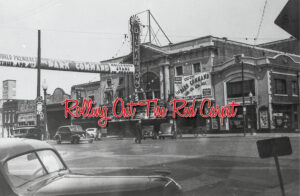| story by | |
| photos | Douglas County Historical Society, Watkins Museum of History |
| OPEN A PDF OF THE ARTICLE |
Power from the Kaw River and budding manufacturing companies in early Lawrence made a big impact on its economy.

Douglas County Historical Society, Watkins Museum of History
In the years following Kansas being granted statehood, three communities were competing to attract residents, commerce and industry: Kansas City, Lawrence and Leavenworth. Before any manufacturing companies could become successful, they needed a power source. In the first decades of settlement, wood from the surrounding area was used to produce energy. But when the wood within a day’s distance was depleted, several Lawrence businesses tried to locate coal deposits as a source of energy. When finding coal in large enough quantities proved futile, a dam on the Kaw River was the only viable option.

Top to bottom: Douglas Co. Mills, Paper Mill, Kimball Bros Foundry
Orlando Darling, a civil engineer, had leased most of the land along the south side of the river by Lawrence. He owned a sawmill, a flour mill, and a stone quarry. Darling proposed building a dam on the Kaw to power his and other Lawrence businesses. He signed an agreement with the city to do so. Darling and other Lawrence residents formed the Lawrence Land and Water Co. (LL&W Co.). The terms of the contract included that Darling finance the cost of construction of the stone dam, that his company would be liable for any damages caused by floods and that he receive ownership of the land in perpetuity. If Darling failed to produce an adequate supply of waterpower, he would lose the lease.
The 1870s saw several unsuccessful attempts to build the dam, with spring’s high water often destroying parts of the dam that had been completed. In 1874, James H. Gower moved to Lawrence from Iowa City, Iowa. He built a flour mill, the Douglas County Mills, and contracted for waterpower from the LL&W Co. In 1877, Gower’s family, including his son-in-law J.D. Bowersock, moved to Lawrence. By that time, the LL&W Co. was in receivership because of the unreliability of the dam and its frequent washouts. On behalf of Bowsersock, Gower bought the debentures issued by order of the court, and Bowersock was issued a deed for the property.
J.D. Bowersock took control of the company after Gower’s death in 1878. He oversaw the necessary repairs to the dam and began selling power to Lawrence businesses. By the mid-1880s, a number of companies were contracting for power from the dam. The mechanical power was delivered to its customers by cables on tall poles or through tunnels. These businesses constructed buildings and hired a number of workers, making an impact on the local economy.
“History of the State of Kansas” was published by A. T. Andreas, of Chicago, in 1883. It contains detailed histories of all of the Kansas counties and many Kansas cities. This history includes profiles of the development of each county and its cities. It also includes listings for the manufacturing businesses in each city. These are the Lawrence companies featured in that 1883 history, many of which J.D. Bowersock had a business interest in.
Note: It was difficult to find definitions of some of the terms used to describe these businesses, so interpretation of some of the meanings is based on common sense assumptions.
Douglas County Mills. It was a flour mill owned by Bowersock after the death of his father-in-law and two other original owners. It occupied a four-story stone structure 50 x 60 feet, as well as a three-story warehouse. The mill had 11 sets of buhrstones for grinding the grain and five sets of rolls for refining the flour.
Pacific Mills. This flour mill had five runs of buhrs and one set of rollers. It had the capacity to produce 100 barrels of four grades of flour every 24 hours.
Pierson Roller Mills. This mill occupied a four-story stone structure the was 50 x 60 feet. It operated four runs of buhrs and 14 sets of rollers. It turned out 250 barrels of flour per day.

1898 Souvenier Douglas Co Mill; Right: Wilder Bros Shirt Factory, Consolidated Barb Wire Mills; below payment receipt Lawrence Gas, Coak and Coal Company and Stock certificate.
Lawrence Paper Mill. Housed in a brick and stone 40- x 60-foot building with an additional wing that was 35 x 90 feet, this mill would produce four tons of wrapping paper daily.
Hamilton Straw Lumber Factory. In the 19th century, straw lumber was either particle board or composite lumber. In 1881-1882, it occupied a 30- x 125-foot building with an addition for storage that was made of straw lumber. It was estimated that the factory produced 10,000 feet of four-ply (board) a day. The company believed its product was becoming a substitute for natural wood.
Lawrence Foundry and Machine Shops. The company invested $30,000 in machinery and a new building in the early 1870s. By 1883, the machine shop was a two-story brick structure that was 40 x 45 feet, and the foundry was a 2300-square-foot brick structure. Fifteen to 25 men were employed by the business.
Douglas County Iron Works. Established in 1882 and operated by Messrs. Savage and Lightcap, both experienced machinists, the two-story brick structure, located at the corner of New Hampshire and Pinckney streets, did general machine work and repairing, but specialized in boiler work.
Lawrence Coal, Coke and Gas Works. This company provided gas lighting to Lawrence in the 1870s. In the 1880s, it produced more than 500,000 cubic feet of gas per month, which was stored in a 60-foot- diameter “gasometer” that could hold 60,000 cubic feet of gas. It was reported that the building contained more than 10 miles of pipe.
Lawrence Canning Factory. Preparing all kinds of fruits and vegetables for canning, this factory filled more than 600,000 containers with produce in 1882.
Kansas Fruit Vinegar Factory. The company employed 20 people and produced 100 barrels of “pure cider vinegar” a day. Its tanks could store up to 200,000 gallons of vinegar. It had a Plummer evaporator that could dry out 100 bushels of fruit a day.
Carriage Works. No owner or operator is mentioned, but the company employed 15 mechanics. It built approximately 100 carriages “of all grades” per year.
Wilder Shirt Factory. J. E. and C. E. Wilder established the factory in 1882 and invested $9,000 in its three-story building, which had an additional two-story wing located at 612 New Hampshire St. During its busy season, 65 people operated 25 machines.
Leis Chemical Works and Patent Medicines. This company manufactured medicine fruit extracts, perfume and baking powder. Its best-known product was Himoe’s Popular Medicine. It had 25 employees.
Kansas Basket Manufacturing Co. This business became a cornerstone of Lawrence manufacturing. Its large stone building was 50 by 100 feet and three stories high. It employed 50 workers, and each year, it consumed $30,000 worth of raw materials. Most of those came from Douglas County, which impacted the local economy. The company produced 50,000 baskets (think peach basket) and 2,000,000 berry boxes per year. In addition, three train carloads of black walnut veneer was produced each week.
Barbed Wire Factories. Lawrence had four barbed wire companies: Frye Combination Fence Works, Lawrence Barbed Wire Manufactory, Southwestern Barbed Wire Manufactory and Western Steel Fence Factory. The wire produced by these factories had individual characteristics, but they all filled the need for barbed wire fencing on the Great Plains. J.D. Bowersock was one of the officers in the Southwestern Barbed Wire company.
Since J.D Bowersock was influential in the construction of the dam and engaged in several of the manufacturing businesses developed in the 1880s, a look at his impact is warranted. He influenced the economic development of his adopted hometown and Kansas. He was born near Columbiana, Ohio, on Sept. 19, 1842. His journey west took him to Iowa City, Iowa, in 1860, where he engaged in grain shipping and pursued other business opportunities. He then moved to Lawrence, Kansas, in 1877. Bowersock started a bank in Lawrence and engaged in the manufacture of flour, paper and barbed wire. He built and maintained the dam across the Kansas River, which powered many of the city’s manufacturers, and he served as president of the Lawrence National Bank, the Lawrence Iron Works, Griffin Ice Co. and Lawrence Paper Manufacturing, among others business establishments. Politically, Bowersock was a Republican and, like many prominent citizens of the era, held a number of elective offices. He served as mayor of Lawrence in 1881 and 1885. He was elected to the Kansas House of Representatives in 1887 and the state senate in 1895. In 1898, Bowersock was elected to the first of four terms in the U.S. House of Representatives, serving from March 4, 1899, to March 3, 1907. He died in Lawrence on Oct. 27, 1922.




